Variation of the Water Level in the Yangtze River in Response to Natural and Anthropogenic Changes
Abstract
1. Introduction
2. Study Area, Methods, and Materials
2.1. Study Area
2.2. Data Collection
2.3. Method
2.3.1. Normalization Method
2.3.2. Division of the Period
2.3.3. Separating the Effects of Climatic and Anthropogenic Factors
3. Results
3.1. Period Division
3.2. Variation Trend of Water Level
3.3. Regression Analysis between the Discharge and Water Level
3.4. Effects of Human Activities and Climate Variation during the Dry Season
3.4.1. Human Activities
3.4.2. Climate Variation
3.5. Effects of Human Activities and Climate Variation during Flood Season
3.5.1. Human Activities
3.5.2. Climate Variation
4. Discussion
4.1. Involved Human Activities and Climate Changes
4.1.1. In the Upper Reaches
4.1.2. In the Middle and Lower Reaches
4.2. Involved Climate Changes
4.3. Evaluation of the Errors of Regression Prediction
4.4. Effects on Irrigation, Navigation, and Riverbank Ecosystem
5. Conclusions
- (1)
- During the dry season, human activities, including riverbed erosion caused by reservoir construction and water–soil conservation projects, water storage in reservoirs, and human water consumption, reduced the water level at the Yichang and shashi stations during 1981–2014; the reduced water levels were 1.280 and 1.717 m, respectively. This reduced water level will aggravate the risks of drought disasters and ecosystem degradation. Human activities, including the water supply and increased bed roughness caused by reservoir operation, increased the water level at the other six hydrological stations, and the increased values varied from 0.103 to 1.662 m.
- (2)
- During the flood season, human activities, including riverbed erosion, increased water usage, increased water storage in reservoirs, and flood peak reduction, reduced the water level in the whole main stem during 1981–2014, and the decreased value varied from 0.019 to 1.621 m. This reduced water level during the flood season can alleviate the risks of flood disasters.
- (3)
- The precipitation from the upper reaches to the estuary showed an increasing trend in both the dry and flood seasons, which can help to increase the water level. During the dry season, the increased water level induced by climate variation varied from 0.076 to 0.272 m and varied from 0.260 to 0.555 m during the flood season. Furthermore, due to the increased extreme precipitation during the 21st century, the effects of climate change on the water level will be enhanced, especially during the flood season, which will need to receive significant attention.
- (4)
- The 175 m impoundment of the TGD has significantly increased the water level of the dry season at the Zhutuo and Cuntan stations since 2008, and the average increased water level can be up to 0.36 and 3.25 m during 2008–2014.
- (5)
- In the reaches between Yichang and Shashi stations, human activities significantly reduced the water level in this reach during the dry season, and the effects were enhanced over time.
Supplementary Materials
Author Contributions
Funding
Acknowledgments
Conflicts of Interest
References
- Trebitz, A.S. Characterizing Seiche and tide-driven daily water level fluctuations affecting coastal ecosystems of the Great Lakes. J. Great Lakes Res. 2016, 32, 102–116. [Google Scholar] [CrossRef]
- Langer, T.A.; Cooper, M.J.; Reisinger, L.S.; Reisinger, A.J.; Uzarski, D.G. Water depth and lake-wide water level fluctuation influence on α-and β-diversity of coastal wetland fish communities. J. Great Lakes Res. 2017, 44, 70–76. [Google Scholar] [CrossRef]
- Ruslan, F.A.; Zain, Z.M.; Adnan, R.; Samad, A.M. Flood water level prediction and tracking using particle filter algorithm. In Proceedings of the IEEE 8th International Colloquium on Signal Processing and its Applications (CSPA), Melaka, Malaysia, 23–25 March 2012; IEEE: Piscataway, NJ, USA, 2012. [Google Scholar] [CrossRef]
- Staes, C.; Orengo, J.C.; Malilay, J.; Rullán, J.; Noji, E. Deaths due to flash floods in Puerto Rico, January 1992: Implications for prevention. Int. J. Epidemiol. 1994, 23, 968–975. [Google Scholar] [CrossRef]
- Donat, M.G.; Lowry, A.L.; Alexander, L.V.; O’Gorman, P.A.; Maher, N. More extreme precipitation in the world’s dry and wet regions. Nat. Clim. Chang. 2017, 6, 508–513. [Google Scholar] [CrossRef]
- Gerten, D.; Rost, S.; Von Bloh, W.; Lucht, W. Causes of change in 20th century global river discharge. Geophys. Res. Lett. 2018, 35, L20405. [Google Scholar] [CrossRef]
- Lehner, B.; Liermann, C.R.; Revenga, C.; Vörösmarty, C.; Fekete, B.; Crouzet, P.; Nilsson, C. High-resolution mapping of the world’s reservoirs and dams for sustainable river-flow management. Front. Ecol. Environ. 2011, 9, 494–502. [Google Scholar] [CrossRef]
- Peng, C.; Wen, J. Strategic opportunities and challenges of soil and water conservation and ecological construction in Yangtze River Basin. Yangtze River 2018, 49, 1–5. (In Chinese) [Google Scholar] [CrossRef]
- Dai, Z.J.; Du, J.Z.; Li, J.F.; Li, W.H.; Chen, J.Y. Runoff characteristics of the Changjiang River during 2006: Effect of extreme drought and the impounding of the Three Gorges Dam. Geophys. Res. Lett. 2008, 35, L07406. [Google Scholar] [CrossRef]
- Dai, Z.J.; Chu, A.; Du, J.Z.; Stive, M.; Du, J.Z.; Li, F.J. Is the Three Gorges Dam the cause behind the extremely low suspended sediment discharge into the Yangtze (Changjiang) estuary of 2006? Hydrol. Sci. J. 2011, 56, 1280–1288. [Google Scholar] [CrossRef]
- Zhu, J.R.; Wu, H.; Li, L.; Yu, B. Saltwater intrusion in the Changjiang Estuary in the extremely drought hydrological year 2006. J. East China Norm. Univ. Nat. Sci. 2010, 4, 1–6. (In Chinese) [Google Scholar] [CrossRef]
- Wu, H.P.; Zeng, G.M.; Liang, J.; Zhang, J.C.; Cai, Q.; Huang, L.; Li, X.D.; Zhu, H.N.; Hu, C.X.; Shen, S. Changes of soil microbial biomass and bacterial community structure in Dongting Lake: Impacts of 50,000 dams of Yangtze River. Ecol. Eng. 2013, 57, 72–78. [Google Scholar] [CrossRef]
- Yang, Y.P.; Zhang, M.J.; Sun, Z.H.; Han, J.Q.; You, X.Y. The relationship between water level change and river channel geometry adjustment in the downstream of the Three Gorges Dam (TGD). Acta Geogr. Sinica 2017, 72, 776–789. (In Chinese) [Google Scholar] [CrossRef]
- Chen, X.Y.; Wang, C.G.; Yin, P. Variations of Annual Water Level of Changjiang River at Jiujiang City and Its Relation with Meteorological Elements. Meteorol. Mon. 2003, 29, 55–57. (In Chinese) [Google Scholar] [CrossRef]
- Jiang, L.Z.; Wang, X.L.; Ban, X. Influence of the Three Gorges project on water level in the Middle Reaches of Yangtze River, China. Adv. Mater. Res. 2014, 934, 279–284. [Google Scholar] [CrossRef]
- Han, J.Q.; Sun, Z.H.; Yang, Y.P. Flood and low stage adjustment in the middle Yangtze River after impoundment of the Three Gorges Reservoir (TGR). J. Lake Sci. 2017, 29, 1217–1226. (In Chinese) [Google Scholar] [CrossRef]
- Sun, Z.H.; Li, Y.T.; Li, M.; Ge, H. Effect of channel degradation on lower level in Yichang-Shashi Reach in the Yangtze River. Hydro Sci. Eng. 2007, 4, 14–20. (In Chinese) [Google Scholar] [CrossRef]
- Sun, Z.H.; Huang, Y.; Cao, Q.X.; Han, J.Q. Spatial and Temporal Variations of the Low Flow Stage in the Immediate Downstream Reach of the Three Georges Dam. J. Basic Sci. Eng. 2015, 694–704. (In Chinese) [Google Scholar] [CrossRef]
- Mei, X.F.; Dai, Z.J.; Gelder, P.H.A.J.M.; Gao, J.J. Linking Three Gorges Dam and downstream hydrological regimes along the Yangtze River, China. Earth Space Sci. 2015, 2, 94–106. [Google Scholar] [CrossRef]
- Yang, Y.P.; Zhang, M.J.; Zhu, L.L.; Liu, W.L.; Han, J.Q.; Yang, Y.H. Influence of large reservoir operation on water-levels and flows in reaches below dam: Case study of the Three Gorges Reservoir. Sci. Rep. 2017, 7, 15640. [Google Scholar] [CrossRef]
- Zhao, J.K.; Li, J.F.; Dai, Z.J.; Wang, Y.B.; Zhang, A.S. Analysis the runoff variotion of Yangtze River in Yichang. Resour. Sci. 2012, 34, 2306–2315. (In Chinese) [Google Scholar] [CrossRef]
- Sun, Z.H.; Li, Y.T.; Ge, H.; Zhu, L.L. Channel erosion processes of transitional reach from gravel river bed to sand bed in middle Yangtze River. J. Hydraul. Eng. ASCE 2011, 42, 789–797. [Google Scholar] [CrossRef]
- Gemmer, M.; Jiang, T.; Su, B.; Kundzewicz, Z.W. Seasonal precipitation changes in the wet season and their influence on flood/drought hazards in the Yangtze River Basin, China. Quat. Int. 2008, 186, 12–21. [Google Scholar] [CrossRef]
- Zhu, L.L.; Yang, X.; Xu, Q.X. Response of low water level change to bed erosion and the operation of Three Gorges Reservoir in upper Jingjiang reach. Acta Geogr. Sinica 2017, 72, 1184–1194. (In Chinese) [Google Scholar] [CrossRef]
- Lai, X.J.; Jiang, J.H.; Yang, G.S.; Lu, X.X. Should the Three Gorges Dam be blamed for the extremely low water levels in the Middle-Lower Yangtze River? Hydrol. Process. 2014, 28, 150–160. [Google Scholar] [CrossRef]
- Mei, X.F.; Dai, Z.J.; Darby, S.E.; Gao, S.; Wang, J.; Jiang, W.G. Modulation of extreme flood levels by impoundment significantly offset by floodplain loss downstream of the Three Gorges Dam. Geophys. Res. Lett. 2018, 45, 3147–3155. [Google Scholar] [CrossRef]
- Chai, Y.F.; Li, Y.T.; Yang, Y.P.; Li, S.X.; Zhang, W.; Ren, J.Q.; Xiong, H.B. Water level variation characteristics under the impacts of extreme drought and the operation of the Three Gorges Dam. Front. Earth Sci. 2019. [Google Scholar] [CrossRef]
- Chai, Y.; Li, Y.; Yang, Y.; Zhu, B.; Li, S.; Xu, C.; Liu, C. Influence of Climate Variability and Reservoir Operation on Streamflow in the Yangtze River. Sci. Rep. 2019, 9, 5060. [Google Scholar] [CrossRef]
- Yang, S.L.; Belkin, I.M.; Belkina, A.I.; Zhao, Q.Y.; Zhu, J.; Ding, P.X. Delta response to decline in sediment supply from the Yangtze River: Evidence of the recent four decades and expectations for the next half-century. Estuar. Coast. Shelf Sci. 2003, 57, 689–699. [Google Scholar] [CrossRef]
- Tang, R.Z.; Duan, H.C.; Sun, H.T. Research on data normalization for SVM training. J. Shandong Norm. Univ. Nat. Sci. 2016, 31, 60–65. (In Chinese) [Google Scholar] [CrossRef]
- Bao, Z.X.; Zhang, J.Y.; Wang, G.Q.; Fu, G.B.; He, R.M.; Yan, X.L.; Jin, J.L.; Liu, Y.L.; Zhang, A.J. Attribution for decreasing streamflow of the Haihe River Basin, Northern China: Climate variability or human activities? J. Hydrol. 2012, 460–461, 117–129. [Google Scholar] [CrossRef]
- Yuan, Y.J.; Zeng, G.M.; Liang, J.; Huang, L.; Hua, S.S.; Li, F.; Zhu, Y.; Wu, H.P.; Liu, J.Y.; He, X.X.; et al. Variation of water level in Dongting Lake over a 50-year period: Implications for the impacts of anthropogenic and climatic factors. J. Hydrol. 2015, 525, 450–456. [Google Scholar] [CrossRef]
- Fekete, B.M.; Vörösmarty, C.J.; Roads, J.O.; Willmott, C.J. Uncertainties in precipitation and their impacts on runoff estimates. J. Clim. 2004, 17, 294–304. [Google Scholar] [CrossRef]
- Miao, C.Y.; Ni, J.R.; Borthwick, A.G.L.; Yang, L. A preliminary estimate of human and natural contributions to the changes in water discharge and sediment load in the Yellow River. Glob. Planet. Chang. 2011, 76, 196–205. [Google Scholar] [CrossRef]
- Li, Z.W.; Xu, X.L.; Yu, B.F.; Xu, C.H.; Liu, M.X.; Wang, K.L. Quantifying the impacts of climate and human activities on water and sediment discharge in a karst region of Southwest China. J. Hydrol. 2016, 542, 836–849. [Google Scholar] [CrossRef]
- Zhong, Y.G.; Power, G. Environmental impacts of hydroelectric projects on fish resources in China. River Res. Appl. 1996, 12, 81–98. [Google Scholar] [CrossRef]
- Xie, H.L.; Dai, Z.J.; Li, W.H.; Lin, Y.F.; Li, J.F. Research on the morphodynamics of distributary mouth between the South and North Passage of Changjiang Estuary. J. Appl. Oceanogr. 2014, 2, 151–159. (In Chinese) [Google Scholar] [CrossRef]
- Yu, S.P.; Yang, J.S.; Liu, G.M. Impact assessment of Three Gorges Dam’s impoundment on river dynamics in the north branch of Yangtze River estuary, China. Environ. Earth Sci. 2014, 72, 499–509. [Google Scholar] [CrossRef]
- Zhang, Q.; Liu, C.L.; Xu, C.Y.; Xu, Y.P.; Jiang, T. Observed trends of annual maximum water level and streamflow during past 130 years in the Yangtze River Basin, China. J. Hydrol. 2006, 324, 255–265. [Google Scholar] [CrossRef]
- Duan, Y.C.; Li, D.X.; Wang, X.K. Analysis of the Sediment Trapping by Reservoirs in the Upper Yangtze River. J. Sichuan Univ. Eng. Sci. Ed. 2015, 47, 15–23. (In Chinese) [Google Scholar] [CrossRef]
- Liao, C.Y. Review and prospect of 60-year soil and water conservation in Yangtze River Basin. Yangtze River 2010, 41, 26–30. (In Chinese) [Google Scholar] [CrossRef]
- Wei, J.; Hou, L.; He, X.B. An assessment of human versus climatic impacts on large-sized basin erosion: The case of the Upper Yangtze River. Nat. Hazards 2014, 74, 405–420. [Google Scholar] [CrossRef]
- Yang, S.L.; Xu, K.H.; Milliman, J.D.; Yang, H.F.; Wu, C.S. Decline of Yangtze River water and sediment discharge: Impact from natural and anthropogenic changes. Sci. Rep. 2015, 5, 12581. [Google Scholar] [CrossRef] [PubMed]
- Yang, S.L.; Milliman, J.D.; Li, P.; Xu, K. 50,000 dams later: Erosion of the Yangtze River and its delta. Glob. Planet. Chang. 2011, 75, 14–20. [Google Scholar] [CrossRef]
- Jia, D.D.; Shao, X.J.; Zhang, X.N.; Lu, Y.J.; Hei, P.F. Morphological responses in a meandering and island-braided reach of the Middle Yangtze River to the Three Gorges Reservoir impoundment. Int. J. Sediment Res. 2016, 31, 131–138. [Google Scholar] [CrossRef]
- Li, J.B.; Zhang, Z.Q.; Ou, C.M.; Li, X.C.; Yu, G.; Liao, X.H. Responses of Water Regimes in Dongting Lake Area under Different Dispatching Modes during the Running Period of the Three Gorges Reservoir. Acta Geogr. Sinica 2011, 66, 1251–1260. (In Chinese) [Google Scholar] [CrossRef]
- Dai, Z.J.; Chu, A.; Du, J.Z.; Stive, M.; Hong, Y. Assessment of extreme drought and human interference on baseflow of the Yangtze River. Hydrol. Process. 2010, 24, 749–757. [Google Scholar] [CrossRef]
- Qiu, C.; Zhu, J.R. Influence of seasonal runoff regulation by the Three Gorges Reservoir on saltwater intrusion in the Changjiang River Estuary. Cont. Shelf Res. 2013, 71, 16–26. [Google Scholar] [CrossRef]
- Zheng, J. Analysis of the Three Gorges Reservoir operation on the water level of Yangtze River during the non-flood season. Adv. Mater. Res. 2013, 864–867, 2207–2212. [Google Scholar] [CrossRef]
- Liu, H.X.; Xu, C.W. Study on scour and bed material armoring of Yichang-Yangjianao channel after TGP impoundment. Hydro. Sci. Eng. 2011, 4, 57–63. [Google Scholar] [CrossRef]
- Guo, Y.; Sun, Z.H.; Luo, F.B. Time-variation characteristics and causes of Yichang low-water level since impoundment of Three Gorges reservoir. Hydro Sci. Eng. 2017, 4, 35–42. [Google Scholar] [CrossRef]
- Zhou, B.T. Projected Changes in Temperature and Precipitation Extremes in China by the CMIP5 Multimodel Ensembles. J. Clim. 2014, 27, 6591–6611. [Google Scholar] [CrossRef]
- Zheng, S.R. Reflections on the Three Gorges project since its operation. Engineering 2016, 2, 389–397. [Google Scholar] [CrossRef]
- Yang, Y.P.; Zhang, M.J.; Liu, W.L.; Wang, J.J. Relationship between Waterway Depth and Low-Flow Water Levels in Reaches below the Three Gorges Dam. J. Waterw. Port Coast. Ocean Eng. 2019, 145. [Google Scholar] [CrossRef]
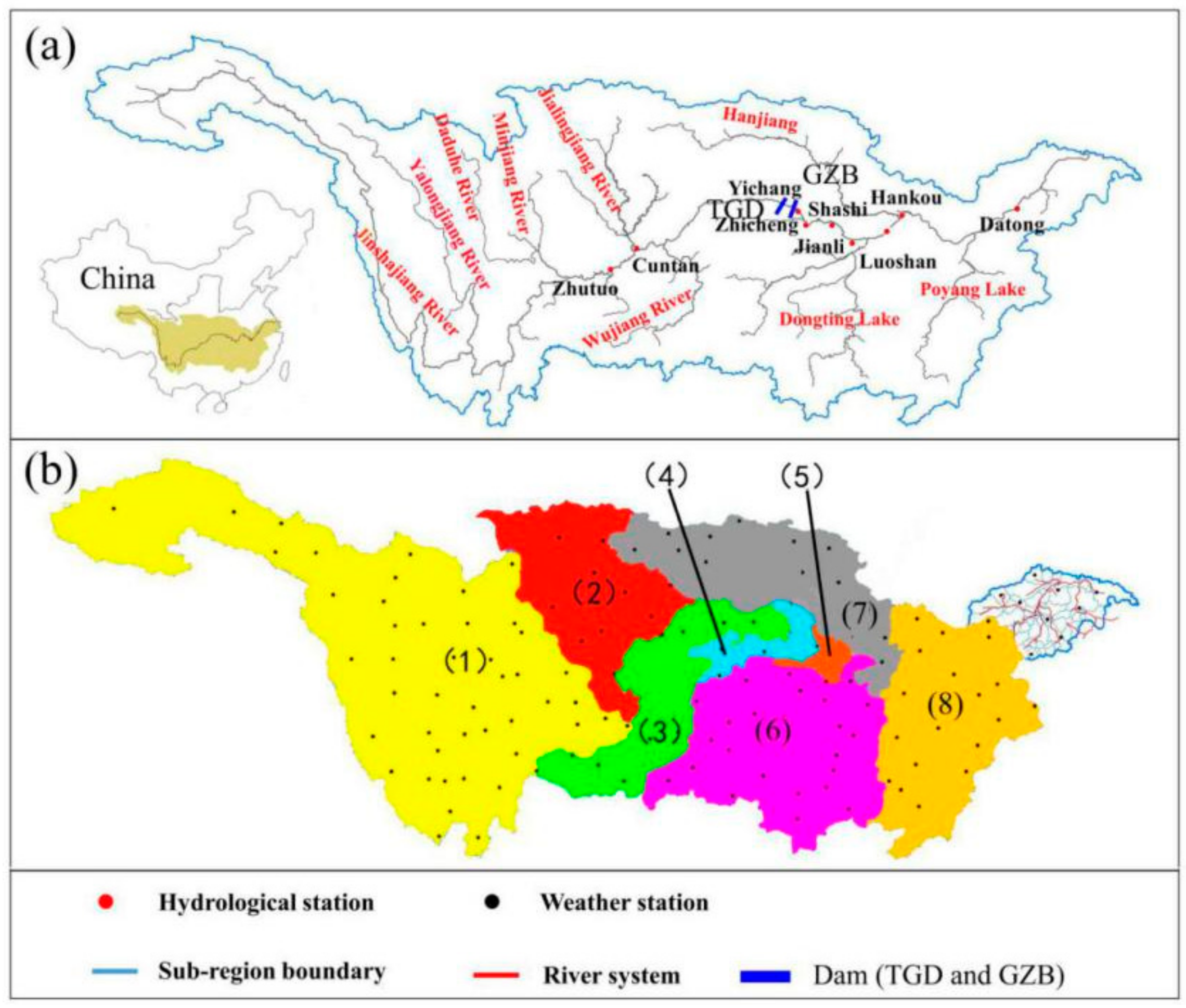

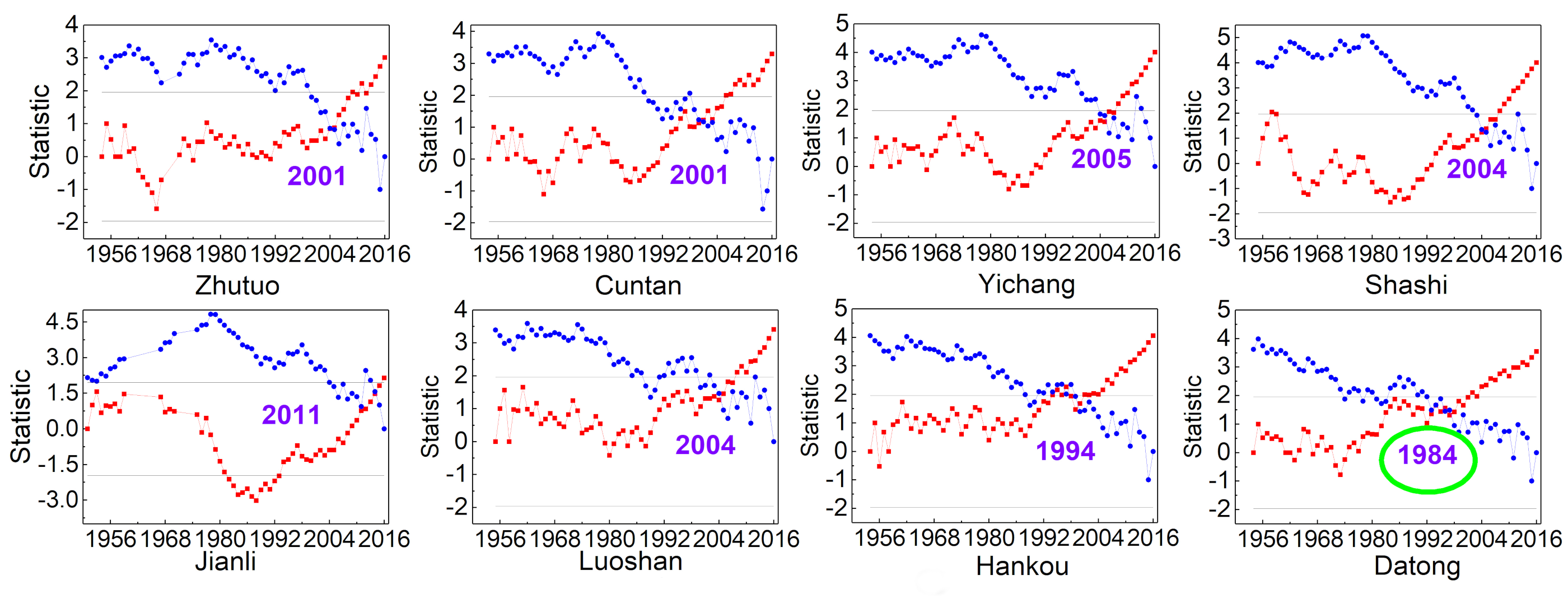
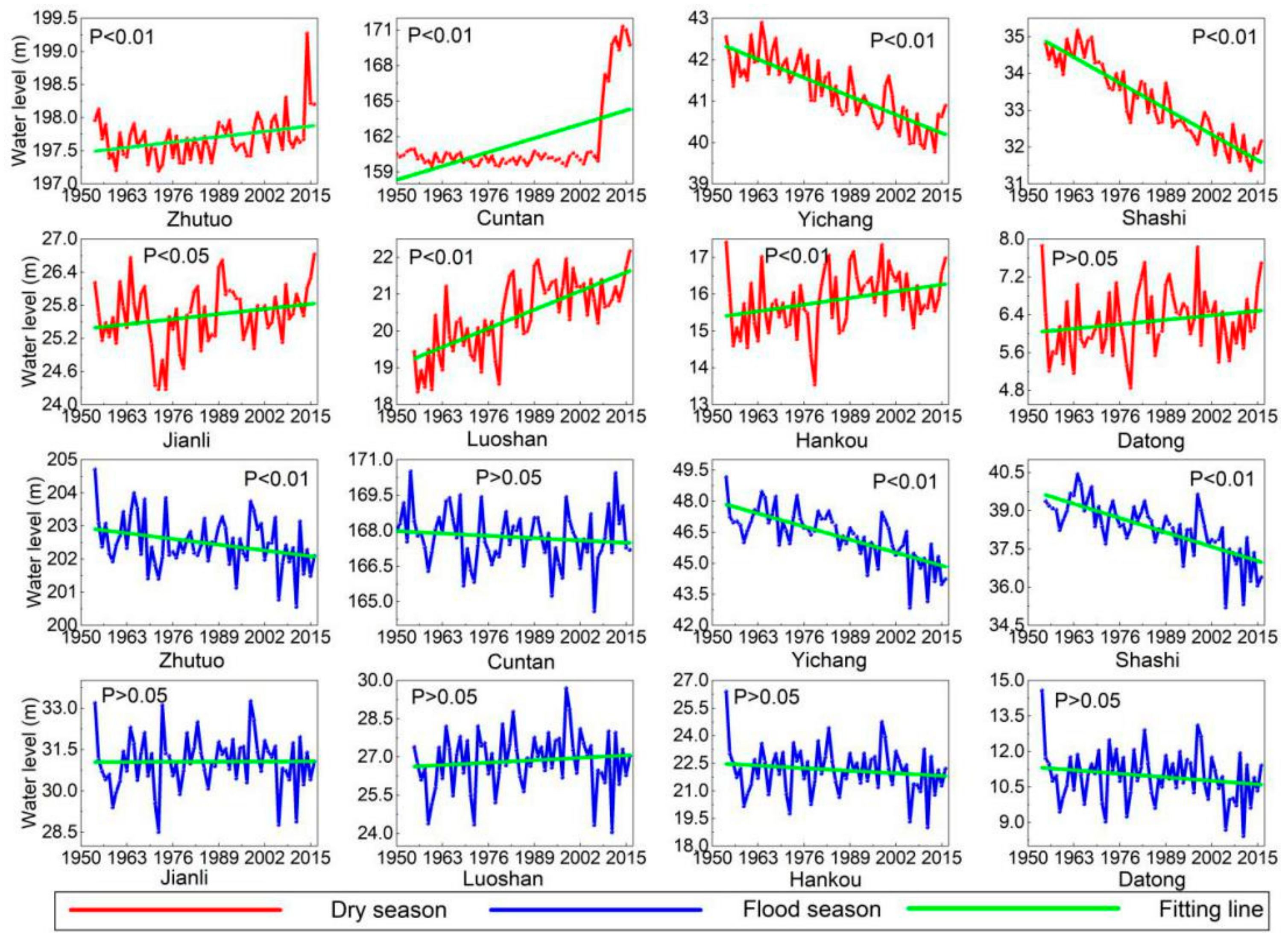
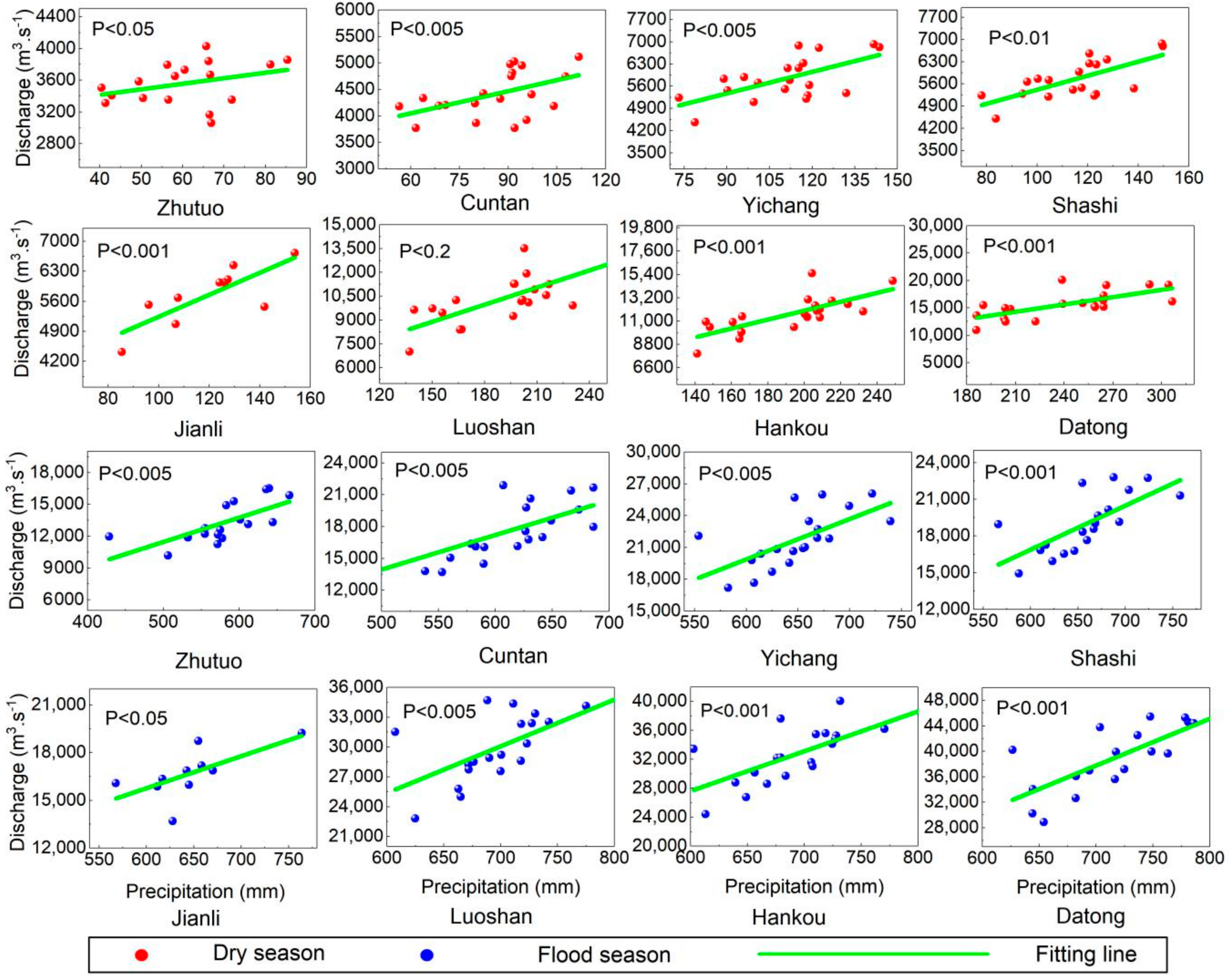

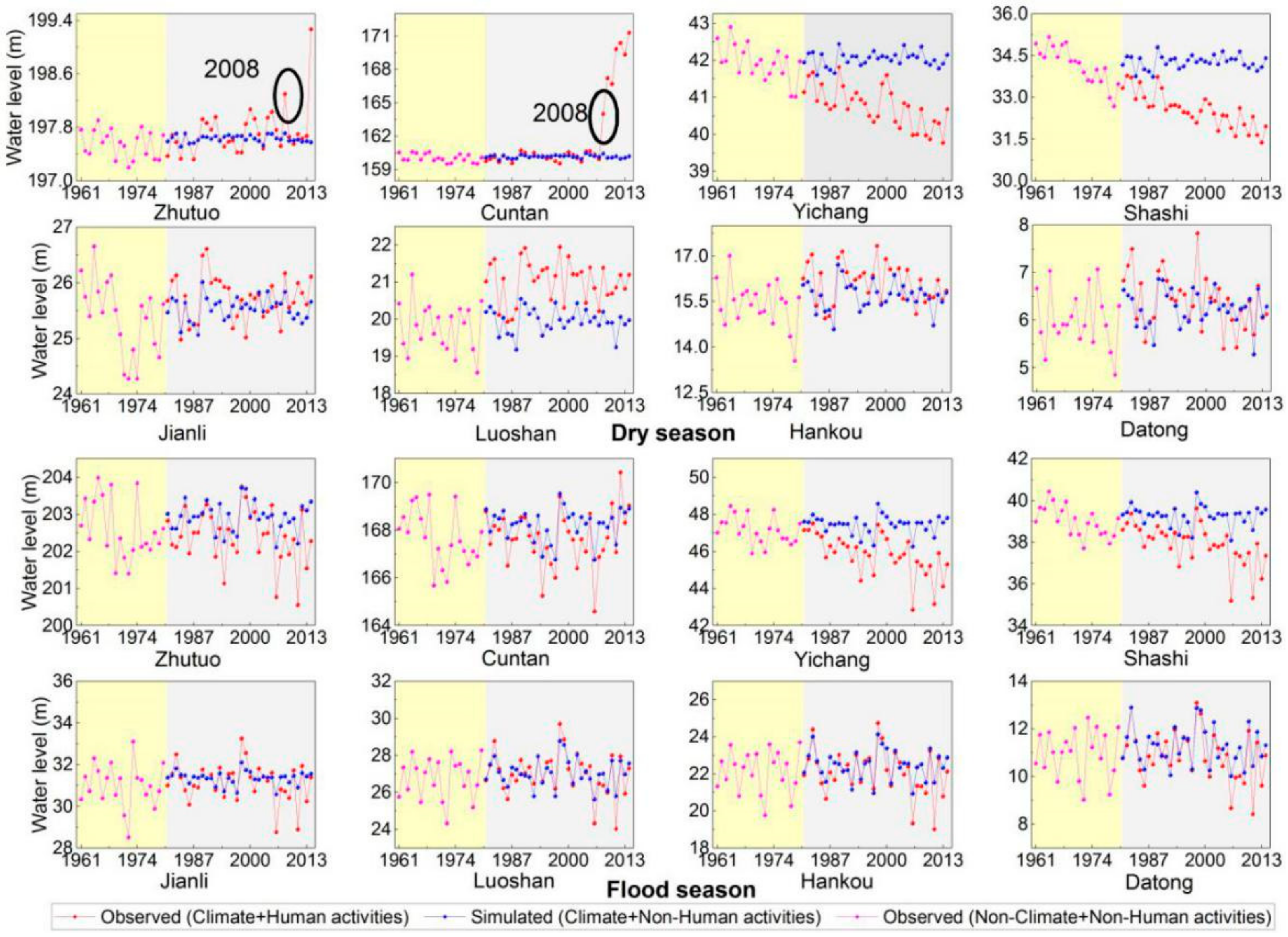

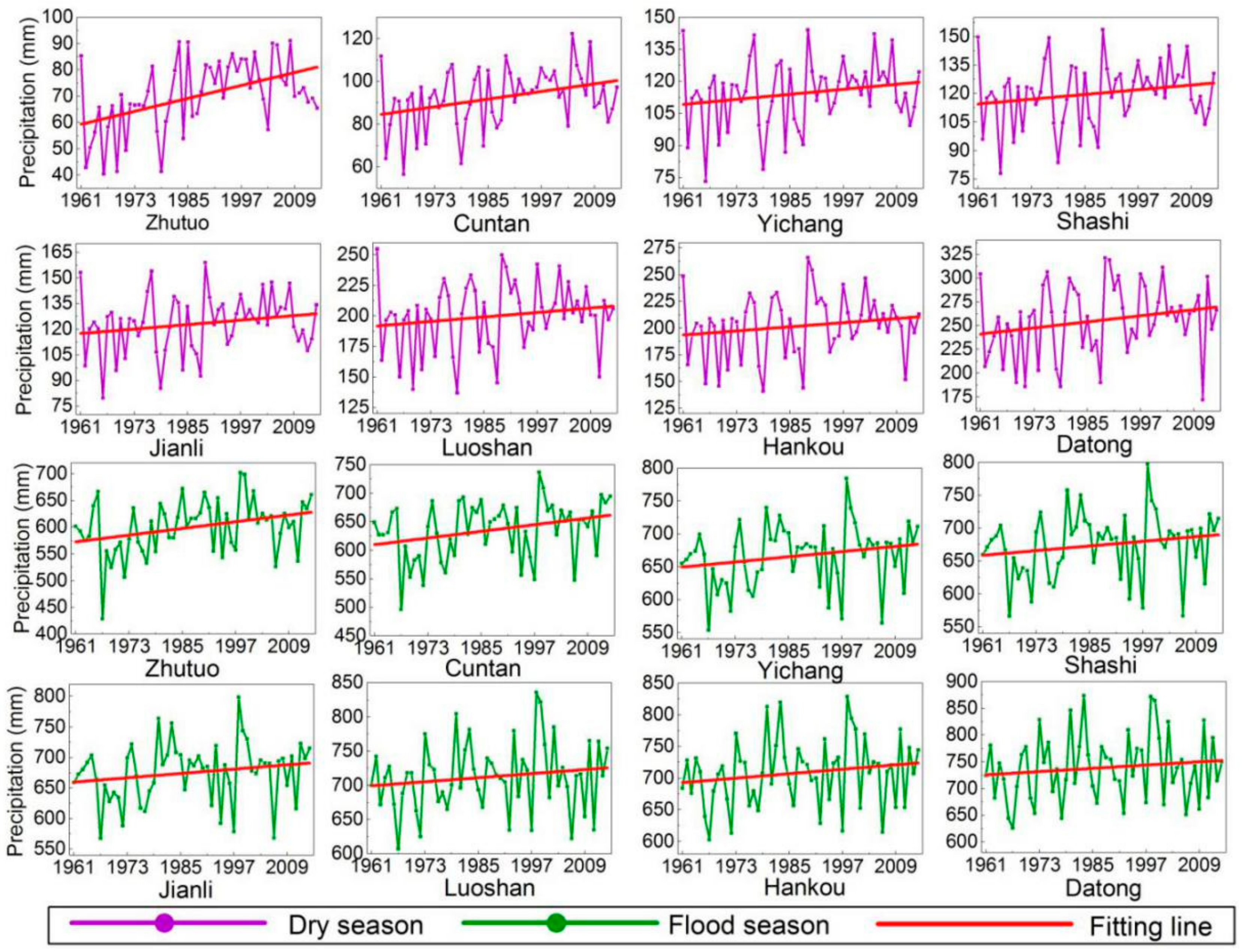
| Station | 1981–2014 | 1981–1990 | 1991–2000 | 2001–2014 | ||||
|---|---|---|---|---|---|---|---|---|
| Dry Season | Flood Season | Dry Season | Flood Season | Dry Season | Flood Season | Dry Season | Flood Season | |
| Zhutuo | 0.179 | −0.197 | 0.042 | 0.005 | 0.126 | −0.053 | 0.315 | −0.444 |
| Cuntan | 1.782 | −0.014 | 0.005 | 0.281 | 0.077 | −0.334 | 4.268 | 0.004 |
| Yichang | −1.183 | −1.33 | −0.735 | −0.490 | −1.057 | −1.145 | −1.593 | −2.061 |
| Shashi | −1.595 | −1.104 | −0.876 | −0.432 | −1.610 | −0.791 | −2.097 | −1.806 |
| Jianli | 0.333 | 0.140 | 0.355 | 0.212 | 0.318 | 0.515 | 0.328 | −0.179 |
| Luoshan | 1.235 | 0.254 | 1.142 | 0.266 | 1.414 | 0.798 | 1.174 | −0.143 |
| Hankou | 0.691 | −0.033 | 0.714 | 0.148 | 0.905 | 0.481 | 0.521 | −0.529 |
| Datong | 0.389 | −0.107 | 0.603 | 0.058 | 0.550 | 0.460 | 0.122 | −0.629 |
| Station | Season | Regression Equation | Slope Values |
|---|---|---|---|
| Zhutuo | Dry season | H = 0.00077Q + 194.82 | 0.00077 |
| Flood season | H = 0.00040Q + 197.32 | ||
| Cuntan | Dry season | H = 0.00087Q + 156.22 | 0.00087 |
| Flood season | H = 0.00045Q + 159.80 | ||
| Yichang | Dry season | H = 0.00065Q + 38.17 | 0.00065 |
| Flood season | H = 0.00028Q + 41.12 | ||
| Shashi | Dry season | H = 0.00078Q + 29.68 | |
| Flood season | H = 0.00028Q + 33.75 | ||
| Jianli | Dry season | H = 0.00056Q + 22.24 | 0.00056 |
| Flood season | H = 0.00033Q + 25.59 | 0.00033 | |
| Luoshan | Dry season | H = 0.00036Q + 16.03 | 0.00036 |
| Flood season | H = 0.00031Q + 17.33 | 0.00031 | |
| Hankou | Dry season | H = 0.00042Q + 10.57 | 0.00042 |
| Flood season | H = 0.00027Q + 13.2 | 0.00027 | |
| Datong | Dry season | H = 0.00024Q + 2.29 | 0.00024 |
| Flood season | H = 0.00018Q + 4.03 | 0.00018 |
| Stations | 1981–1990 | 1991–2000 | 2001–2014 | 1981–2014 | ||||||||
|---|---|---|---|---|---|---|---|---|---|---|---|---|
| Zhutuo | 0.042 | 0.025 | 0.067 | 0.126 | 0.027 | 0.098 | 0.315 | 0.248 | 0.067 | 0.179 | 0.103 | 0.076 |
| Cuntan | 0.005 | 0.079 | 0.083 | 0.077 | 0.072 | 0.149 | 4.268 | 4.144 | 0.124 | 1.782 | 1.662 | 0.119 |
| Yichang | 0.735 | 0.786 | 0.052 | 1.057 | 1.172 | 0.115 | 1.593 | 1.710 | 0.116 | 1.183 | –1.280 | 0.097 |
| Shashi | 0.876 | 0.945 | 0.069 | 1.610 | 1.748 | 0.138 | 2.097 | 2.247 | 0.150 | 1.595 | –1.717 | 0.123 |
| Jianli | 0.355 | 0.240 | 0.115 | 0.318 | 0.148 | 0.147 | 0.328 | 0.147 | 0.182 | 0.333 | 0.174 | 0.159 |
| Luoshan | 1.142 | 0.967 | 0.175 | 1.414 | 1.221 | 0.192 | 1.174 | 0.987 | 0.187 | 1.235 | 1.050 | 0.185 |
| Hankou | 0.714 | 0.434 | 0.280 | 0.905 | 0.638 | 0.267 | 0.521 | 0.251 | 0.270 | 0.691 | 0.419 | 0.272 |
| Datong | 0.603 | 0.345 | 0.258 | 0.550 | 0.288 | 0.262 | 0.122 | 0.115 | 0.238 | 0.389 | 0.139 | 0.251 |
| Stations | 1981–1990 | 1991–2000 | 2001–2014 | 1981–2014 | ||||||||
|---|---|---|---|---|---|---|---|---|---|---|---|---|
| Zhutuo | 0.005 | 0.377 | 0.382 | 0.053 | 0.397 | 0.344 | 0.444 | 0.749 | 0.305 | 0.197 | 0.536 | 0.339 |
| Cuntan | 0.281 | 0.432 | 0.713 | 0.334 | 0.688 | 0.355 | 0.004 | 0.582 | 0.586 | 0.014 | 0.569 | 0.555 |
| Yichang | 0.490 | 0.897 | 0.406 | 1.145 | 1.390 | 0.245 | 2.061 | 2.303 | 0.242 | 1.33 | 1.621 | 0.291 |
| Shashi | 0.432 | 0.815 | 0.383 | 0.791 | 1.016 | 0.224 | 1.806 | 2.004 | 0.197 | 1.104 | 1.364 | 0.260 |
| Jianli | 0.212 | 0.208 | 0.420 | 0.515 | 0.200 | 0.315 | 0.179 | 0.472 | 0.293 | 0.140 | 0.197 | 0.337 |
| Luoshan | 0.266 | 0.034 | 0.300 | 0.798 | 0.348 | 0.451 | 0.143 | 0.270 | 0.127 | 0.254 | 0.019 | 0.273 |
| Hankou | 0.148 | 0.278 | 0.427 | 0.481 | 0.056 | 0.425 | 0.529 | 0.723 | 0.194 | 0.033 | 0.363 | 0.330 |
| Datong | 0.058 | 0.275 | 0.332 | 0.460 | 0.055 | 0.515 | 0.629 | 0.704 | 0.075 | 0.107 | 0.387 | 0.280 |
© 2019 by the authors. Licensee MDPI, Basel, Switzerland. This article is an open access article distributed under the terms and conditions of the Creative Commons Attribution (CC BY) license (http://creativecommons.org/licenses/by/4.0/).
Share and Cite
Liu, J.; Deng, J.; Chai, Y.; Yang, Y.; Zhu, B.; Li, S. Variation of the Water Level in the Yangtze River in Response to Natural and Anthropogenic Changes. Water 2019, 11, 2594. https://doi.org/10.3390/w11122594
Liu J, Deng J, Chai Y, Yang Y, Zhu B, Li S. Variation of the Water Level in the Yangtze River in Response to Natural and Anthropogenic Changes. Water. 2019; 11(12):2594. https://doi.org/10.3390/w11122594
Chicago/Turabian StyleLiu, Jinxin, Jinyun Deng, Yuanfang Chai, Yunping Yang, Boyuan Zhu, and Sixuan Li. 2019. "Variation of the Water Level in the Yangtze River in Response to Natural and Anthropogenic Changes" Water 11, no. 12: 2594. https://doi.org/10.3390/w11122594
APA StyleLiu, J., Deng, J., Chai, Y., Yang, Y., Zhu, B., & Li, S. (2019). Variation of the Water Level in the Yangtze River in Response to Natural and Anthropogenic Changes. Water, 11(12), 2594. https://doi.org/10.3390/w11122594






